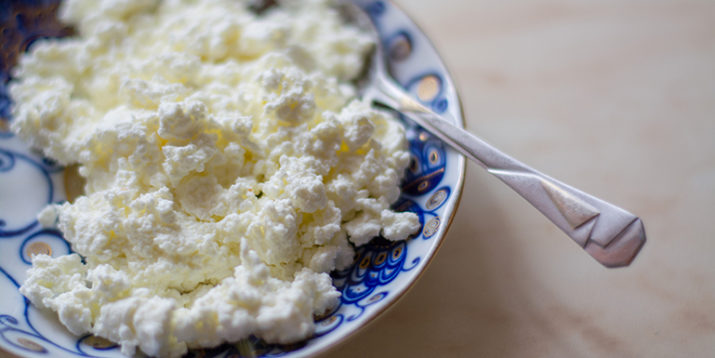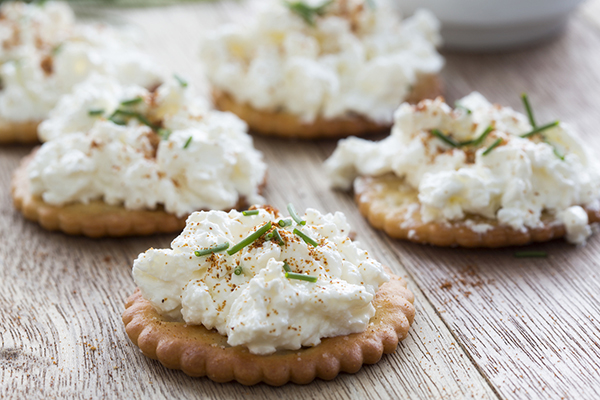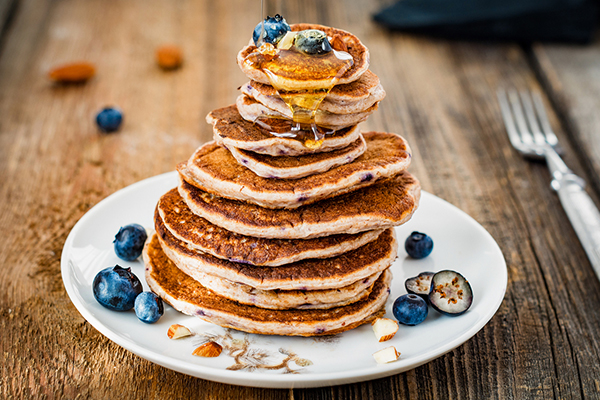Why Cottage Cheese Is Cool Again

Cottage cheese benefits were heralded in the ’70s, but cottage cheese soon went the way of quiche and deviled eggs.
But as with most fads, what’s old is new again: Cottage cheese is officially cool again.
With the spike in interest in gut health, probiotics, and non-meat sources of protein, people are appreciating cottage cheese benefits (again).
These days you can buy souped-up versions of cottage cheese, with fruit and other toppings, including savory ones.
It’s important to know that these combos, much like yogurts with various add-ins, usually contain added sugar and other additives.
If you don’t like plain cottage cheese, you’re better off buying plain and adding your own fruit, herbs, or spices, etc.

And if you’re feeling particularly ambitious, you can easily make your own cottage cheese at home.
Fun Fact: Small curd cottage cheese is more tart, while large curd tends to taste sweeter. Large curd is made with rennet, similar to aged cheeses; small curd isn’t.
The rennet, which can be derived from animal or vegetable sources, speeds up the curdling process of milk. This process makes for a sweeter flavor; the tartness of small curd cottage cheese is a result of slower and longer fermentation.
Not down with cottage cheese yet, Miss Muffet?
Here’s everything you need to know about it, cottage cheese recipes, and how you can incorporate this cool-kid cheese into your diet.
(FYI, all you Portion Fix people out there, 2-percent cottage cheese is 1 red container!)
Cottage Cheese Benefits
Probiotics
Cottage cheese is a fermented food, so it usually contains probiotics.
If you’re unsure if the brand you like has this beneficial bacteria, look for the word “cultured” on the label.
Even better, find a brand that says “cultured after pasteurization” — that means the live cultures weren’t heated (and thus destroyed) during the pasteurization process.
Protein
Cottage cheese is high in protein, edging out Greek yogurt by a hair: One cup (226 g) of low-fat/two-percent cottage cheese contains about 24 grams of protein, while a container of low-fat Greek yogurt (200 grams) contains about 20 grams of protein.
It’s worth noting that cottage cheese contains sodium, so look for no-salt-added or low-sodium brands.
Fat
Cottage cheese is sold in full-fat (four percent), reduced-fat (two percent), low-fat (one percent), and nonfat varieties.
Note that even the full-fat variety weighs in at just under five grams of fat per four-ounce serving, making it much lower in fat than most other cheeses.
Note: If you’re watching your salt intake, be aware that a cup of cottage cheese (small curd) contains about 800 milligrams of sodium, so look for low-sodium options.
For reference, the U.S. Dietary Guidelines recommend no more than 2,300 milligrams of sodium per day for adults.

How to Eat More Cottage Cheese
Sure, you could eat it straight out of the container — but there are endless ways to enjoy cottage cheese.
Here are seven tasty and unique ideas to eat more cottage cheese:
1. Dips
Whip cottage cheese with olives for a creamy tapenade that has more protein and less fat than a fully olive-based one, with just as much olive aroma and flavor.
Or swap in cottage cheese for any dip recipe that calls for sour cream as an ingredient.
2. Cornbread
Yup, you read that right: You can add up to a full cup of cottage cheese to cornbread batter for extra moisture and protein.
Use small curd if you don’t want to see pieces of it in the final product!
3. Guacamole
Avocados are full of healthy fats that are good for you, but a serving size is ¼ of a medium-sized avocado.
Get more out of your guacamole by using less avocado and more cottage cheese to get the same delicious result.
4. Mac and cheese
If you’re looking to cut calories and add more protein to everyone’s favorite comfort food, blend up some cottage cheese and add it to the cheese sauce to make it more creamy and rich.
5. Mashed potatoes
Most people add the high-fat deliciousness of butter and sour cream to their mashed potatoes, but you can cut the fat and up the protein by swapping one or both of them out for cottage cheese.
This healthy trade works for any kind of potato preparation: baked potato, potato skins, latkes — skip the dollop of sour cream and spoon on cottage cheese instead.
6. Ice cream and smoothies
Say what? Yes, you can use cottage cheese as the base for homemade ice cream.
I’ve made chocolate ice cream out of cottage cheese, and no one who ate it was any the wiser. Simply swap out the milk/sugar/cream mixture and replace it with blended cottage cheese.
You can also add a dollop to your next smoothie for a boost of protein and creaminess.
7. Sweet spread
Blend cottage cheese with maple syrup and cinnamon for a better bagel or toast spread than cream cheese.
You can also use cottage cheese to make stuffed French toast, add it to your oatmeal for more volume, or pop a smear on a date (or two) for a bite-sized dessert.
Since cottage cheese has such a mild flavor, you can use it in virtually any recipe that calls for dairy without worrying about affecting the taste. (Watch your back, Greek yogurt!)

Check out these other fun cottage cheese recipes:
Whole-Wheat Protein Pancakes
Add them to your next batch of whole wheat pancakes for an extra kick of protein.
Sweet Breakfast Taco
Make like a taco and wrap cottage cheese and a tropical fruit like mango or pineapple in a whole wheat tortilla.
Cloud Bread
Bake Instagram-worthy Cloud Bread with cottage cheese instead of Greek yogurt.
Cottage Cheese and Chickpeas With Chili Powder
Put together this simple, easy, high-protein snack to help you stay full between meals.
